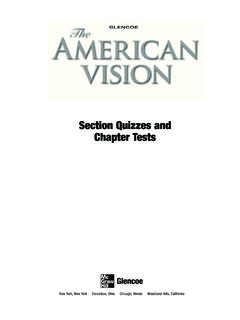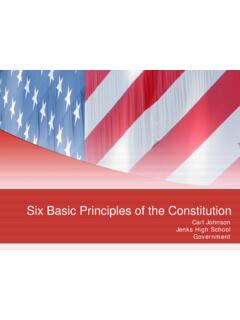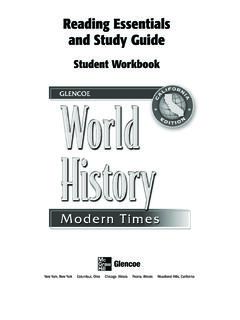Transcription of Examining sources relating to Australia’s Federation and ...
1 COPY 9 Examining sources relating to Australia s Federation and ConstitutionWarning Aboriginal and Torres Strait Islander teachers and students are advised that this curriculum resource may contain images, voices or names of deceased GUIDE YEAR 6 HASS HISTORY & ANALYSINGYEAR 6 HASS HISTORY & ANALYSING 1 Australian Curriculum Link Humanities and Social Sciences/Year 6/Knowledge and Understanding/History/ACHASSK134 Humanities and Social Sciences/Year 6/Inquiry and Skills/Analysing/ACHASSI126 Australian Curriculum Content Description ACHASSK134 Key figures, events and ideas that led to Australia s Federation and constitution . ACHASSI126 Examine primary sources and secondary sources to determine their origin and 6 HASS HISTORY & ANALYSINGE xamining sources relating to Australia s Federation and ConstitutionAustralian Curriculum Elaboration ACHASSK134 Studying Australia s path to Federation through an examination of key people (for example, Henry Parkes, Edmund Barton, George Reid, John Quick) and events (for example, the Tenterfield Oration, the Corowa Conference, the referendums held in the colonies between 1898 and 1900).
2 ACHASSI126 Identifying and distinguishing fact and opinion in information and identifying stereotypes and over-generalisations (for example, over-generalisations about the role of women, the contribution of Aboriginal and Torres Strait Islander Peoples, the work of politicians, the beliefs of religious groups).Essential question What do primary and secondary sources tell us about how the creation of the constitution , and the Federation of Australia, impacted Aboriginal and Torres Strait Islander Peoples, cultures and histories? ACARA code: ACHASSK134 ACARA code: ACHASSI126 YEAR 6 HASS HISTORY & ANALYSING 2 Australians Together Learning Framework Tells Australia s narrative through the lens of 5 Key Ideas that inform teachers and students about Aboriginal and Torres Strait Islander past that shapes our story as a nationStudents will critically engage with Australia s stories and understand the impact our history continues to have on Aboriginal and Torres Strait Islander people and all who call Australia s it got to do with me?
3 Students will explore why Aboriginal and Torres Strait Islander histories and cultures are relevant to them today. Everyone has culture. Know about your culture and value the cultures of othersStudents will learn more about their own culture and identity, and gain a better understanding of, and respect for, Aboriginal and Torres Strait Islander cultures. Steps we can take to build a brighter future Students will gain an understanding that a brighter future is possible for all Australians, but to get there we each need to play our part. Injustice from the impact of colonisation Students will recognise the pain and disadvantage many First Nations people experience, that started at colonisation and continues Terms that may need to be introduced to students prior to teaching the resource: activist: a person who works to bring about change. censuses: official government surveys that collect population data about every citizen.
4 The Australian Bureau of Statistics (ABS), a government agency, collects data for the Australian Census every four years. colonisation: the act of one country invading and taking over : an area or a country that is separate from but under the rule of another country and is occupied by settlers from that ruling country. constitution : a document of the rules by which a nation is governed, and the rights the citizens are entitled recognition: the adding of a statement to the Australian constitution that acknowledges Aboriginal and Torres Strait Islander Peoples as the First Peoples of Australia. Elder: a leader or senior person in an Indigenous community; a custodian of language and cultural : the joining together of separate states to establish one Nations people: Aboriginal and Torres Strait Islander people. primary source: objects or documents that are original, or first-hand accounts, that are created or written during the time being investigated.
5 Referendum: a vote for all enrolled voters asking a question about whether the rules of the government should be changed. rights: a rule by law of what a person is allowed to do, or allowed to source: documents of writing, or accounts about the past, that were created after the time being investigated. stereotype: an over-simplified and fixed view of a particular person or Custodians: people who are the original inhabitants of Australia. YEAR 6 HASS HISTORY & ANALYSING 3 Teacher guidanceIdeas for student activitiesIntroductionBefore beginning the study, it s important to ask students to access their prior knowledge about the topic with an introductory question or unit examines the impact of Australia s Federation and constitution on Aboriginal and Torres Strait Islander Peoples, cultures and history. Ideally, students will have prior knowledge of events leading up to Federation , and reasons for and against will use primary sources and secondary sources to explore the impact of Federation on Aboriginal and Torres Strait Islander Peoples.
6 They ll explore resistance to colonisation, movements to amend the constitution and how exclusion from the Australian constitution led to events in the 20th and 21st centuries. With teacher guidance, students will explore how lack of recognition can affect the way laws and policies are made. Students will consider and examine contemporary movements for recognition and come up with their own thoughts on how constitutional recognition and representation could impact Aboriginal and Torres Strait Islander Peoples. Note that the Federation questions development activity allows students to work with the Civic and Citizenship Questioning and research skill resources To begin the backgrounding of this topic, ABC Behind The News have a brief overview of Federation in the video Federation of Australia (4:37): #!/media/1957410/ Federation -of-australia Parliamentary Education Office (PEO) s resource, The Federation of Australia, can be used to explore the reasons for Federation in more detail.
7 There is a notable exclusion of Indigenous perspectives on this site: questions development Watch the ABC Behind The News video Federation of Australia (4:37) as a through the Parliamentary Education Office webpage, The Federation of Australia , either as a class or small groups, write ten questions that could be answered by watching and reading the resources seen so far. Use different question words to get people thinking who, what, when, where, why. Swap questions with another group and attempt to answer the questions they analysis In pairs or small groups, take a closer look at the two primary sources on the PEO webpage from 1896 Combine Australia! and Don t be in such a hurry gentlemen! Consider fact, opinion, stereotype and over-generalisation, as well as message. Share your thinking as a class discussion or debate Hold a class discussion or debate to explore reasons for and against the Federation of are many stories that make up Australia s history.
8 It s important to use resources that include perspectives and voices of First Nations people, such as those contained in this a nation From 1788 until 1901, Australia was made up of a handful of colonies of the British Empire. In 1889, Sir Henry Parkes, Premier of New South Wales, gave a speech at Tenterfield, New South Wales, where he called for all colonies to come together as a nation. We now refer to this speech as The Tenterfield presentation In small groups, use primary and secondary sources to research and prepare a two-minute presentation for the class on a key figure or event from Australia s path to Federation . Report on where you found your sources and how reliable you believe they are. treaty: a formal agreement between countries or two groups of people (in this case the Australian Government and First Nations Peoples), usually over the use of land or the rules of trade.
9 Wurundjeri: an Aboriginal nation of the Woiwurrung language group, situated around the present location of Melbourne, Victoria. Yorta Yorta: an Aboriginal nation of the Yorta Yorta language group, situated around the present location of Goulburn, north-eastern Victoria, and southern New South 6 HASS HISTORY & ANALYSING 4 Teacher guidanceIdeas for student activitiesIn the years following his speech, referendums were held across Australia for voters to approve the draft of the Australian constitution and for the colonies to join together to become a nation. Although the majority of voters said yes to Federation and the constitution , many people weren t eligible to vote. In fact, the government at the time passed a law which denied all Aboriginal and Torres Strait Islander people federal voting rights (AEC, 2019).Henry Parkes, Edmund Barton, George Reid and John Quick are considered the key fathers of Australian Federation .
10 They are all non-Indigenous men. Evidence of their attitudes towards Aboriginal and Torres Strait Islander people isn t easy to find. What we do know is that the constitution that was written at Federation excluded First Nations people and didn t recognise Aboriginal and Torres Strait Islander people as the Traditional Custodians of the land. Primary sources and secondary sources from prior to Federation and post- Federation reveal the impact this exclusion had on Aboriginal and Torres Strait Islander fight for rights and recognition of First Nations Peoples Since colonisation, Aboriginal and Torres Strait Islander people have fought for rights to the land that they have lived on, and cared for, for many thousands of years. For example, Wurundjeri Elder, William Barak ( 1903), fought the closure of his traditional lands at Coranderrk, Victoria, throughout the late 19th century (Aboriginal Victoria, 2019).






